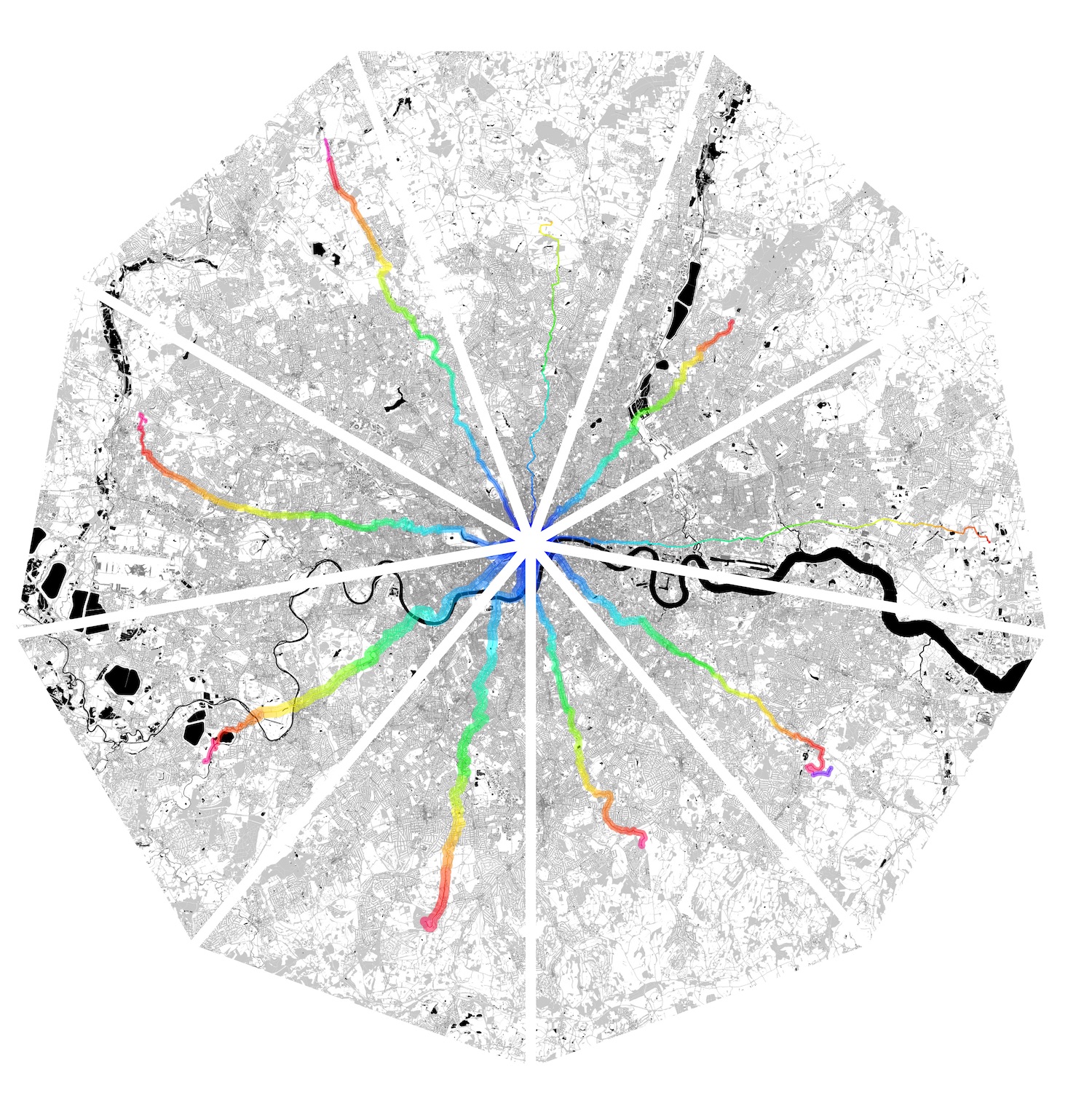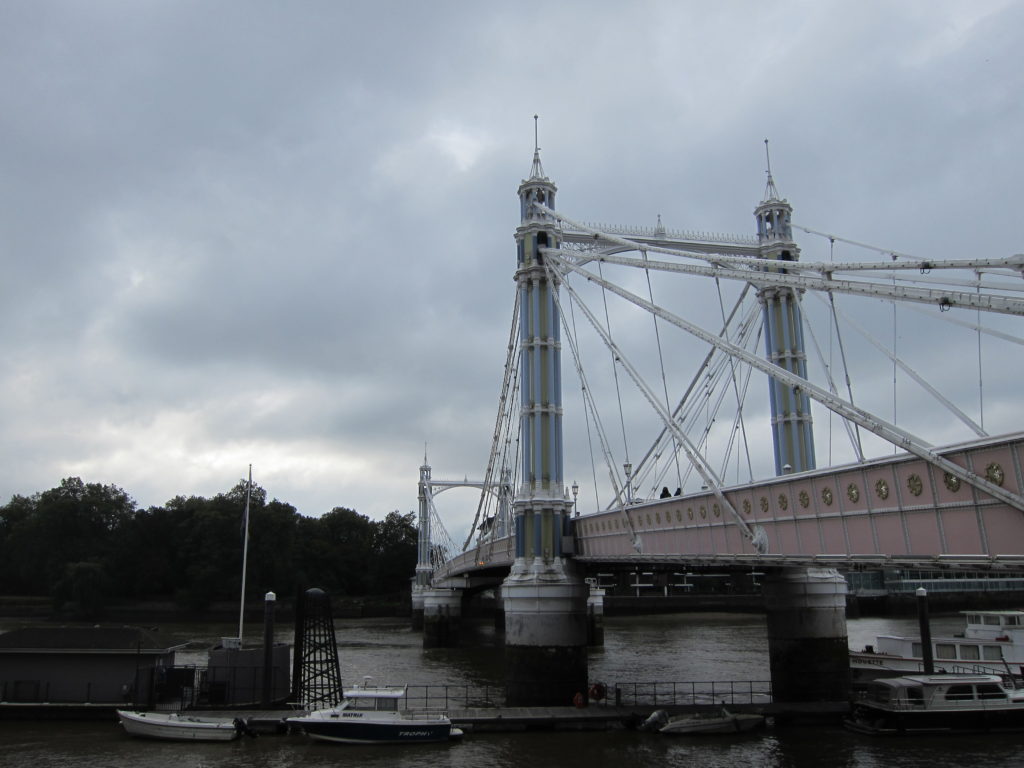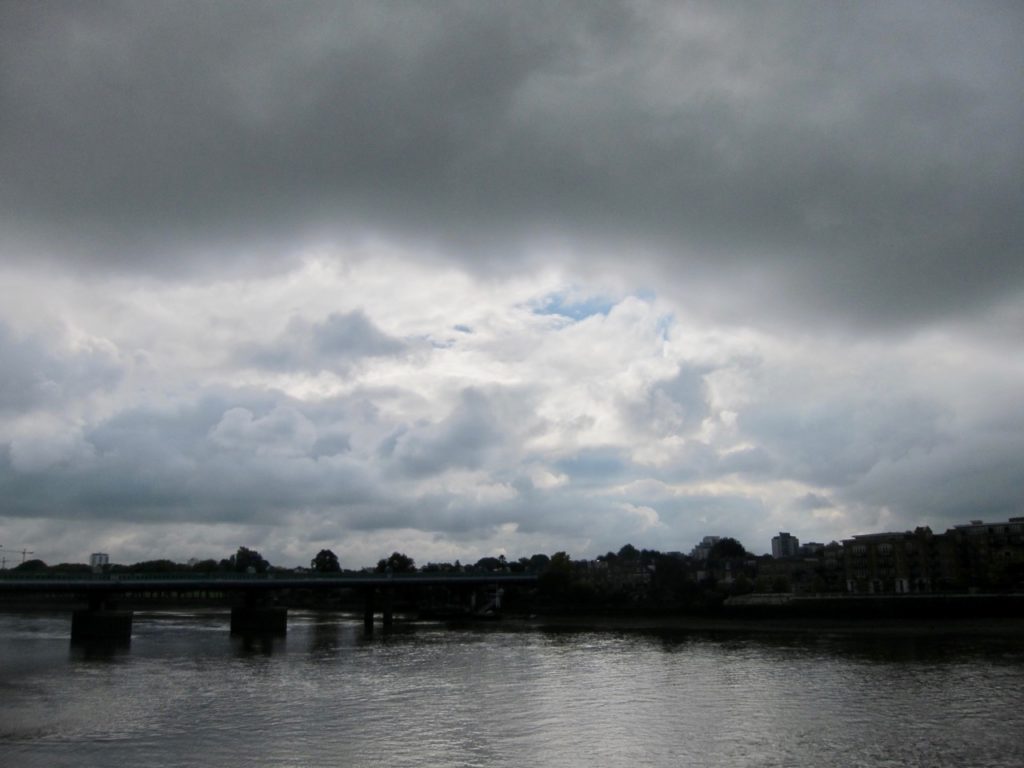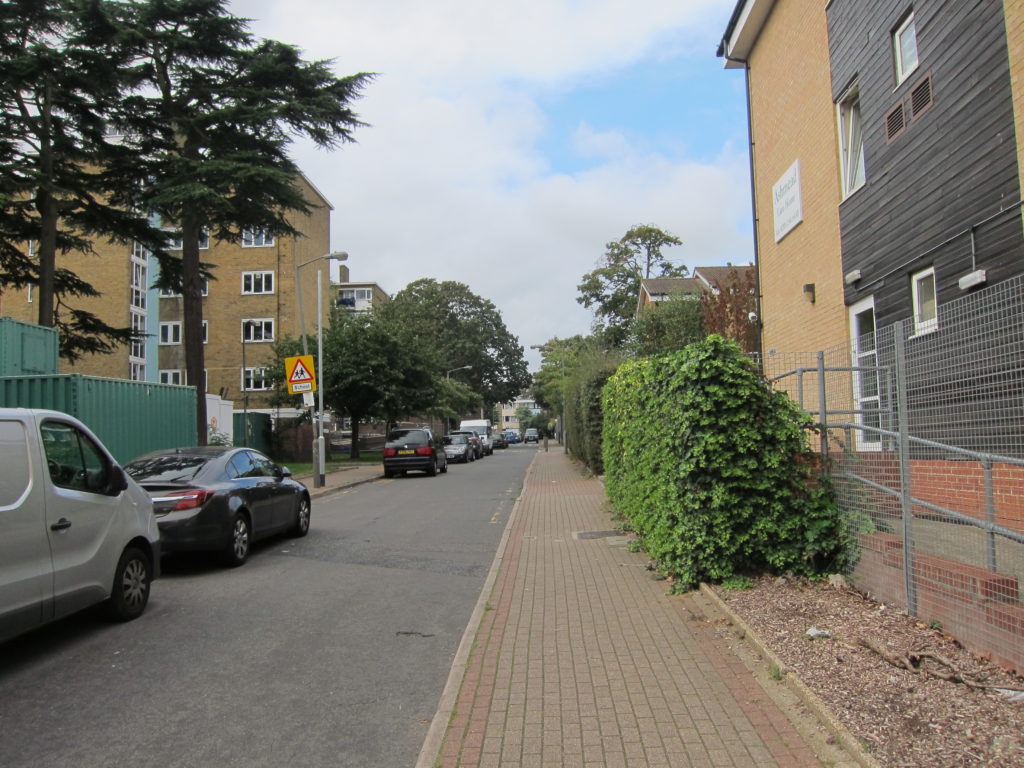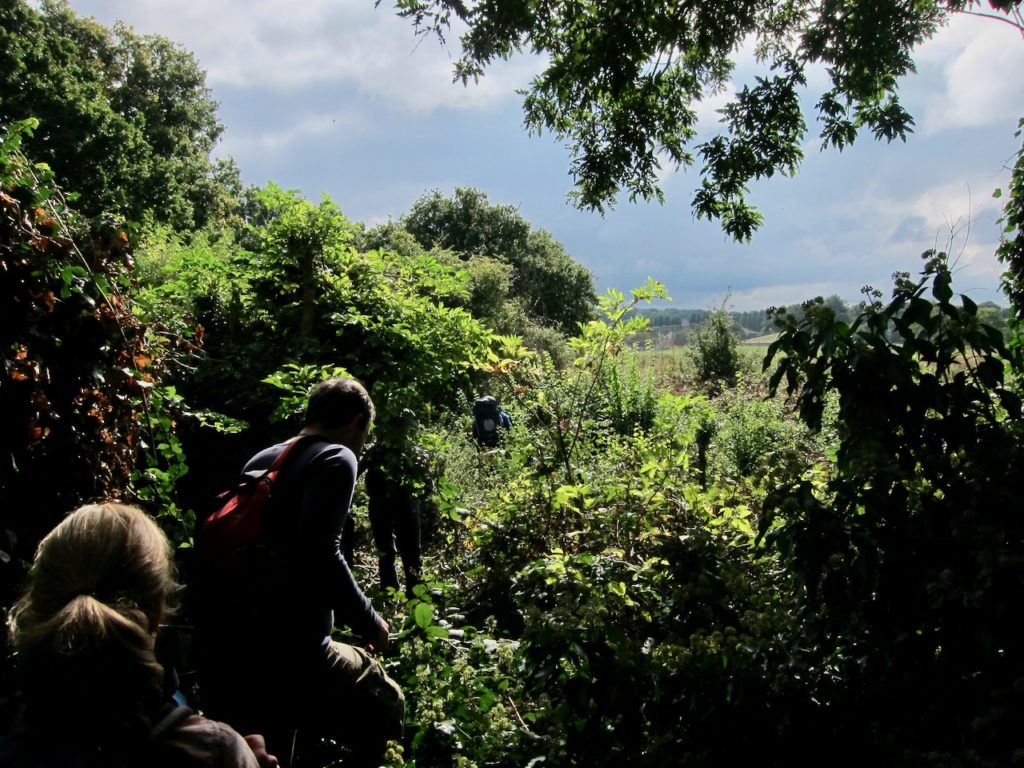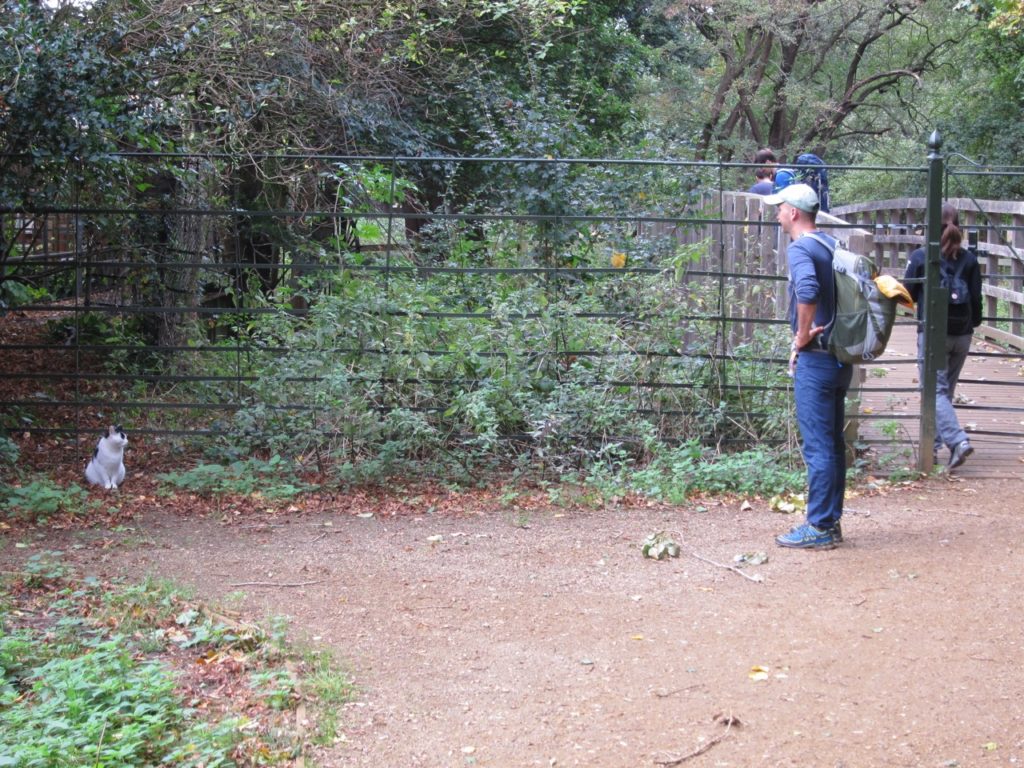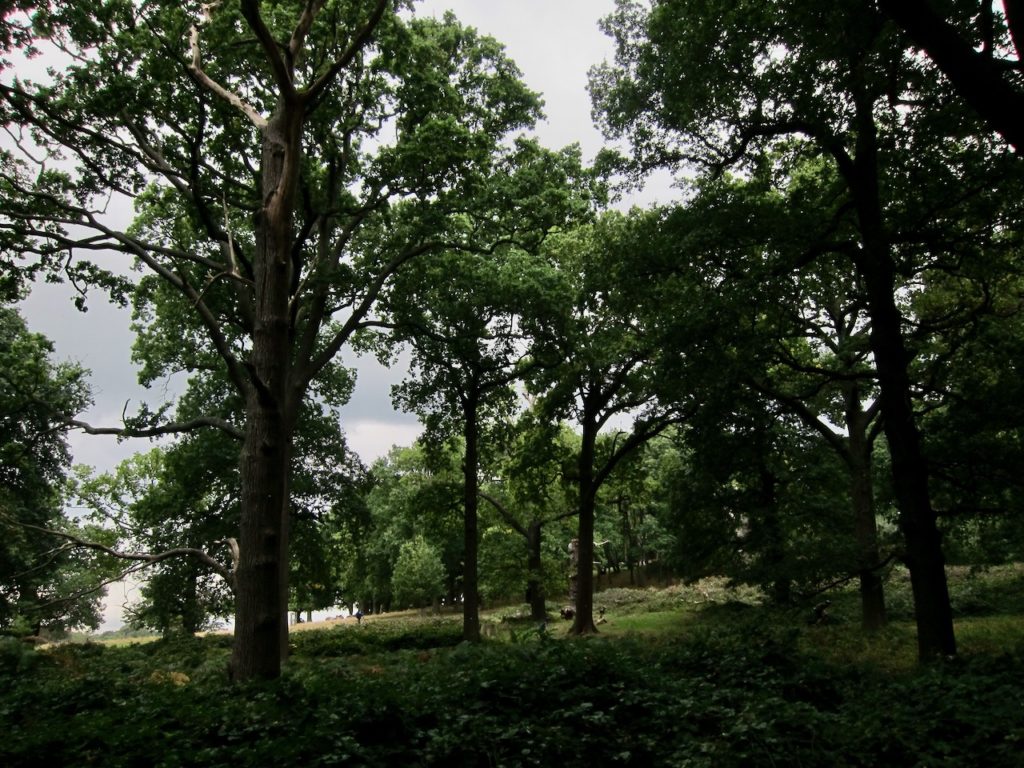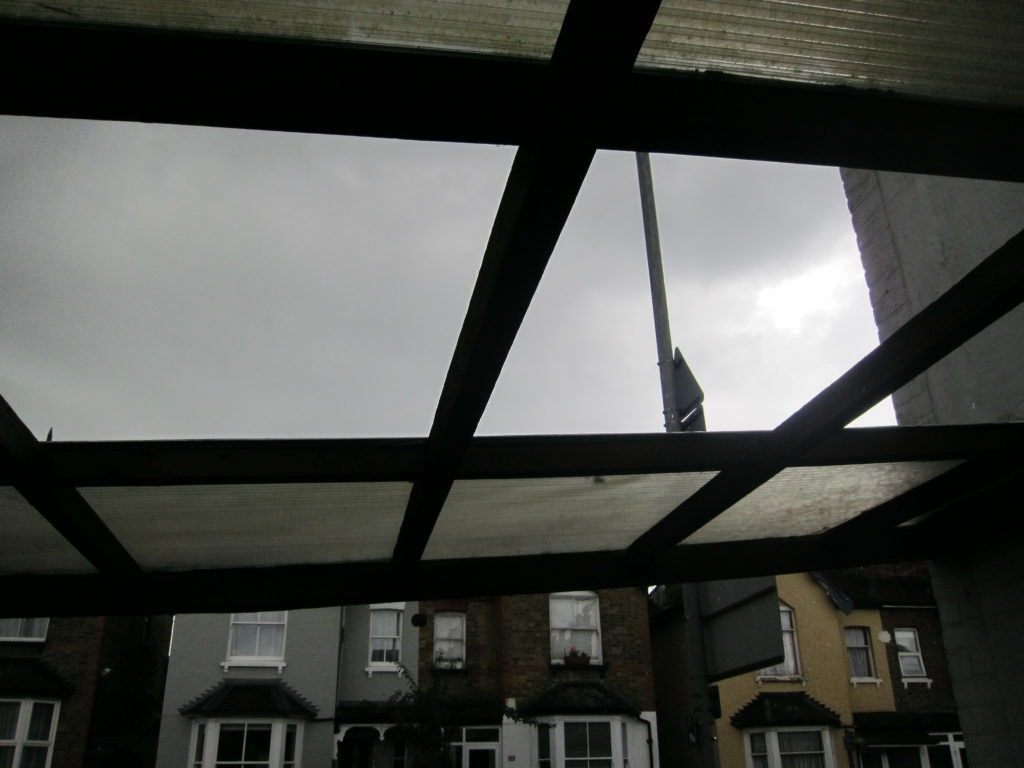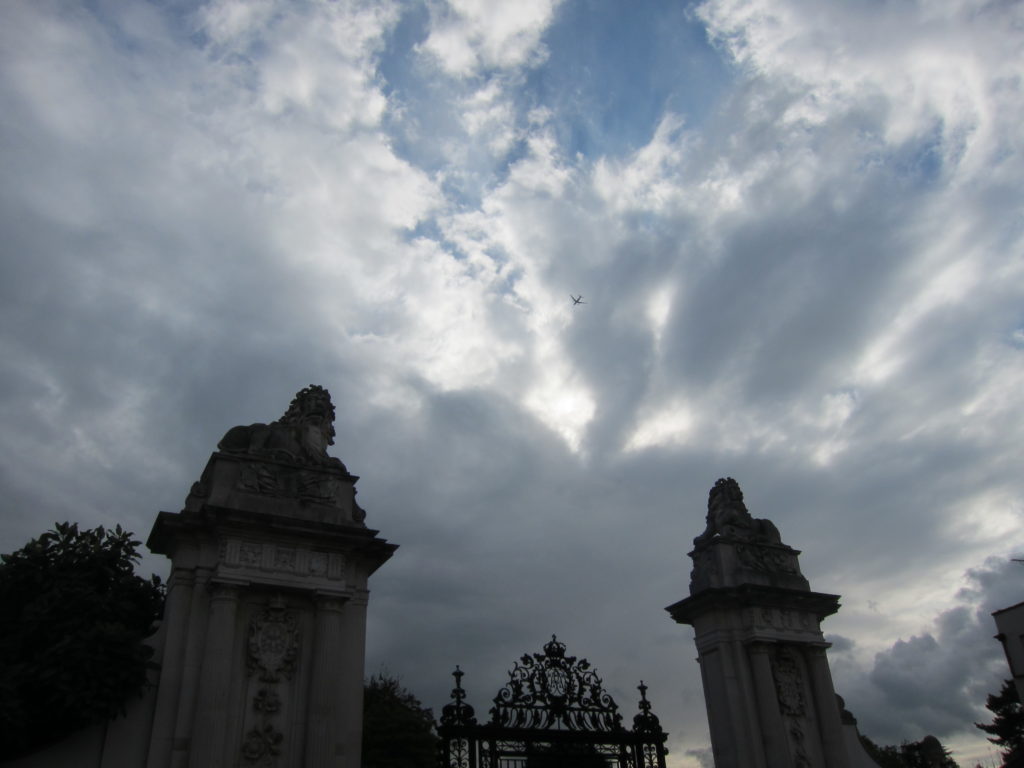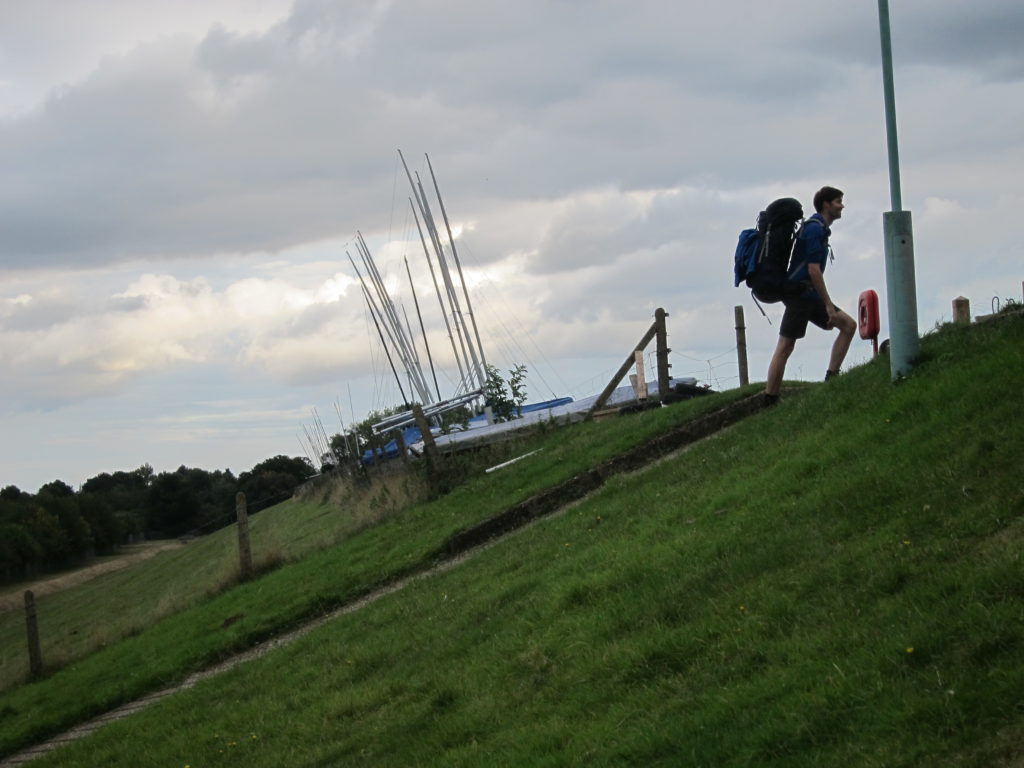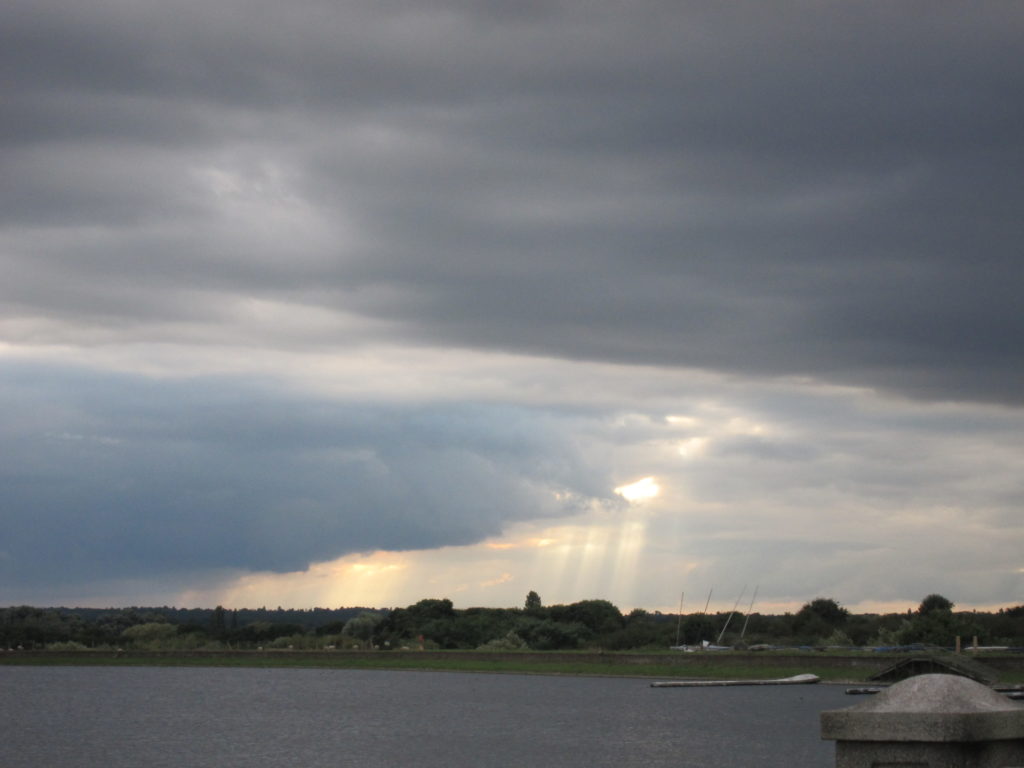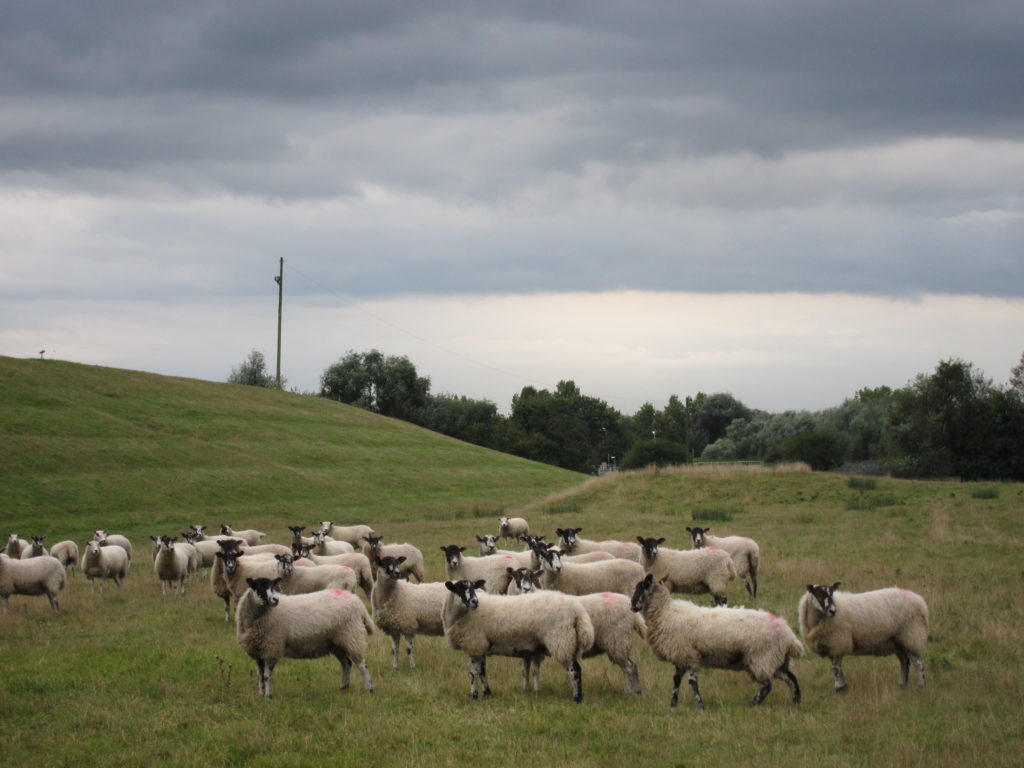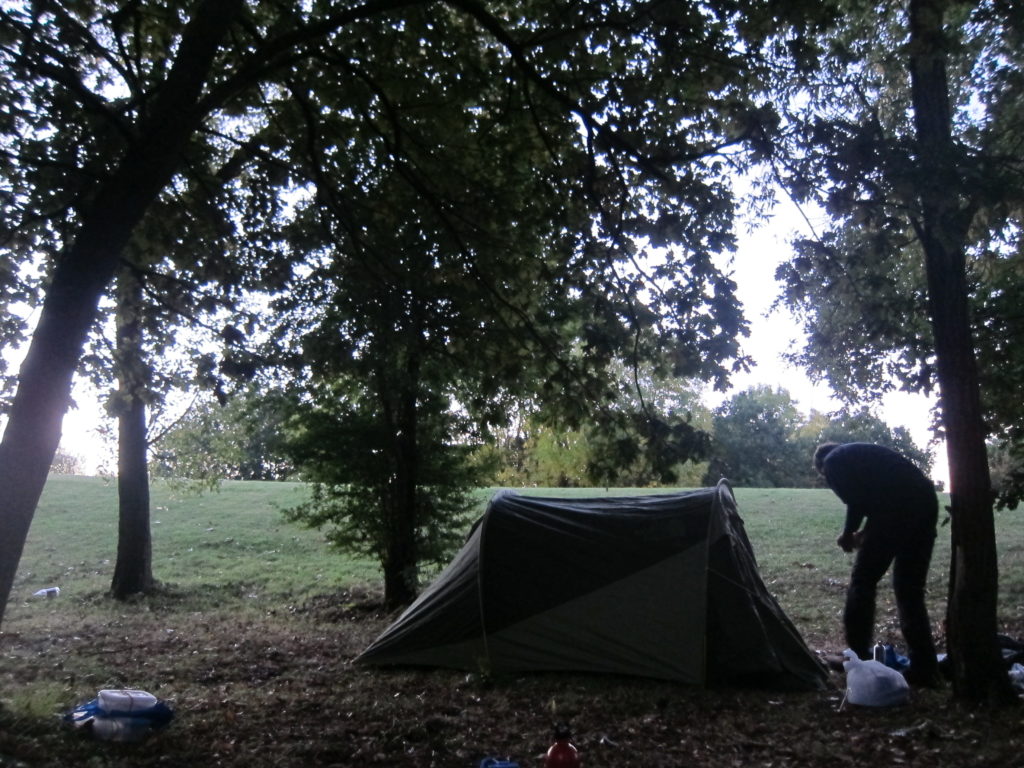I had stayed at Sarah’s place the previous night. This time she was joining. I was nine weeks into recurring relapses of a mystery illness, and was apprehensive, fearing a relapse as I’d had after the previous walk. We got up, did some yoga, and made porridge. I had coffee. Soon we scrambled out of the flat, stopping for pastries and another coffee en route. The weather was grey and cold. I had had dinner with Sandy during the week, and he had suggested it might rain all day. Thankfully, however, it seemed stable.
Matt and Marita were awaiting us with Matt’s brother Joe and Joe’s friend Emily. Next, Tom joined us. Seven of us. A good number. While I prepared Marita ran to the toilet. Queen’s Guards cantered around the roundabout, and groups of tourists as large as our group gathered to photograph the statue. We met Marita as she returned and set off, straight down The Mall, close to 240°.
We talked among ourselves. A slow-moving film crew drove slowly toward Charing Cross from the Palace escorted by police on motorcycles. Crew vehicles lined the road on the other side.
At the Palace we ducked under railings and ran across the road, true to the compass. We skirted to the left of the Palace and continued through Chelsea. The road, straight; urban walking, talking, thinking. Tom remarked on the Chelsea Physic Garden: the oldest herbal garden in England? I talked about my illness.
As we continued through residential Chelsea we passed Le Poulet Pot restaurant with a sign of a chicken in a pot. A farmer’s market graced the pavement outside the restaurant, tempting us with samples.
After an hour we hit the river near the Albert Bridge at Battersea, but opted not to cross: the compass directed us along the river’s north bank. Soon we were diverted away from the river, falling in step with a local couple, Henry and Anna, with a rich maple-coloured dog. They asked how long we were out for. “Just the night”, I said. “Looks like you’re off for a couple of weeks”, Henry responded. I invited them to join us on a future walk as we parted ways.
We continued into the Worlds End Estate, a homogenous body of replicated, expensive-looking modern flats, and soon arrived at the Chelsea Harbour and Imperial Wharf Overground station. Tom joked that we could pop in on Larena, who was working nearby. We took a tunnel under the station. Then, past yellow-brick modern flats. A window cleaner hung suspended, cleaning the windows of the top floor of a building.
South of Fulham we declined another opportunity to cross the river. The direction just wasn’t quite right, and soon a brick wall diverted us, sequesterimng a private club. Apparently the club’s restaurant was good, but not great. We followed the wall, safe in the knowledge that, at least, we were on the Thames Path. A park opened up at the end of the wall. Troupes of children played football. We stopped and played on the rope slide in the adventure playground, and settled down for ten minutes of elevensies. Sarah had a polenta cake that was a big hit. On the far side of the park a chocolate dog with short legs shot after a tennis ball thrown by its owner, faultlessly catching the ball mid-air.
After a quarter of an hour we set off again, crossing the park toward a low building that suggested toilets. Another dog, huge and white, floated effortlessly across the field as if on tip-toes. To our disappointment, the building didn’t have toilets. We skimmed the remaining edge of the park, following use trails, and emerged back onto streets by stepping over a low line of railings.
We crossed the Thames on the bridge into Putney. As we crossed, I recalled sitting on a bench in the park one winter’s night long ago with Giovanni, overlooking the river, wrapped in longcoats, and sharing cigars and a bottle of cognac. We stopped outside the cinema in Putney and took it in turns to make toilet trips. No-one in the cinema seemed to notice, or care.
When everyone was finished, we headed on. The compass directed us into a shopping mall, a horseshoe which looped us back to the main road. It wasn’t as fun as the mall we went through on a previous walk. As we exited, the rain came, momentarily, prompting pedestrians to reach for umbrellas and coats. We weaselled off the road into immaculate suburban streets. Over the road, a kid was manhandled by his older brother. Glorious cedars hovered, canopies paralleling the road.
A man passing in the opposite direction made eye contact with Tom. After he was gone we looked back, to see no trace of the others. Later, we discovered that he and Matt had played disc golf together, and had stopped to talk. We remarked on the polite apartment blocks that we were passing, then dropped into a housing estate with green play areas. Subtly, the housing became disheveled. Nevertheless, some had marvellously wide windows, reminding me of Holland. At the back of the estate we slipped easily onto a gravel track to the edge of Wimbledon Common.
We skirted the common and down a wooded hill, the green mass of Richmond Park ahead. A crescent of modernist townhouses lay to our right. I felt hot; Tom asked how I was. It was reassuring to have the park ahead. At the bottom of the hill the road curved left, but a path lay ahead, bluntly ending in a housing estate. The group had split, and I was in front; while waiting for the others, I ventured down the path to the wall at the end of a grassy strip between houses. Reaching the wall, a path revealed itself between the wall and the rear of houses’ gardens. I gestured the others to join me. It reminded me of the scene in Labyrinth where perspective hid an opening in a wall. I peered over the eight-foot-high wall to see a mess of brambles, with the promise of parkland beyond. It seemed an opportunity not to be missed, so I propped my bag against the wall and stood on it to clamber on top of the wall, then jumped down the other side. Brambles and woods, scattered litter, glorious no-man’s land. The others clambered over to join me, iteratively passing backpacks, using clasped hands as footholds into the wilderness space. No-one from the overlooking houses noticed; if they did, no-one deemed it worthwhile to yell at us. Tom came last. With no-one to help him up, he chimneyed between the wall and the fence at the rear of the gardens. We were excited and congratulatory of each other; an adventure outside of the usual bounds of the city, yet within the city.
Next we needed to escape the brambles into the park. We turned right, but found the way overgrown, and retraced our steps. After picking our way through the undergrowth to the left, however, past abandoned shopping trolleys and piles of rubbish, we found the nettles and brambles closing in. Someone suggested using a discarded ironing board to bridge the undergrowth, but Matt had been pioneering an escape through the thicket along our original route. We followed him, emerging blinking into sunlight. Instead of the park we had been expecting, we were on a golf course.
Within minutes we were chased down by an American warden in a golfcart. We shouldn’t have been here. It was dangerous. He pointed us to the clubhouse. We walked sheepishly through a sparse throng of golfers outside the clubhouse. The building was a sleek wooden affair with a sign suggesting that the course had been built in the 1920s. We crossed a stream at the back of the club house near the entrance. A footpath sign pointed us down a wide earthen track, and we followed a sign to Richmond Park, with the golf course on our right through trees, and houses to our left behind a high brick wall.
As we walked down the track, it sifted us like a chromatogram into smaller cliques. After many minutes, we reached our entrance to Richmond Park at a bridge over a wide stream. A handsome black-and-white cat sat awaiting our arrival with disinterest. Watched over by the cat, we played pooh sticks, then walked on into the park, taking another earthen track, following the compass, and looking for picnic spots. The park was busy with day trippers.
A few minutes later, we found a secluded clearing beneath a tree. It was around 1:15pm and we were all excited to stop for lunch. Rice crackers, rockett, falafel. I took a chocolate chip cookie from Tom. Conversation skipped lightly; Roald Dahl’s adult stories, Leg of Lamb; Popular films. It rained again, but we were sheltered. After almost an hour we picked ourselves up, tidied up, and set off again.
The earthen bike path led up a low hill, before we turned off on singletrack into the woods. The weather improved. Cyclists passed, with kids following on smaller bikes. Big trees. We talked of islands in rivers. Then, downhill, along a tributary path, a narrow singletrack with brambles. The woodland expansive, with large trees and low-lying undergrowth. The compass kept us hugging the border of the park. Soon we emerged at the base of the park at Kingston Gate. A toilet block charged 20p so I peed in the bushes. We walked on, past a water fountain, and filled our water bottles. Then, back into the suburbs.
We proceeded down Kings’ Road. Soon, a burst of rain prompted us to dash for shelter under a nearby porch. Umbrellas and jackets came out again, and we resumed our trajectory. At the end of the road we reached the edge of Kingston’s shopping centre. There weren’t many other pedestrians, and we took a route along a mosaic-lined pedestrian path before dropping down through backstreets to the river. From there we could clearly see our route: a stone bridge, upriver. We walked along the paved riverside, climbed stairs to the bridge, and crossed the river. It was 3pm.
We continued our trajectory along the riverside along a major road, housed between tall, old brick walls. The walk became fascinating, yet interminably boring. Surrounding us on each side were Hampton Court’s fields. The traffic heading back the way we came looked miserable, moving slowly. The windows of many cars were open, and a few people commented to us. I found a ball of socks on the pavement, which I carried faithfully until we all stood as a group. No-one was missing socks, though. I left them on a fencepost.
The sky, overcast; the terrain, uninspiring, anti-pedestrian. We yearned for an escape from the road. As we walked, a small metal gate promised an exit, but it was only a route into the fields. A map on the side of the pavement told us that we were close to Hampton Court Palace, so we decided that we’d stop there for toilets and rest.
We arrived into Hampton Court and walked through the gardens until we found a bench as a base for a break. The sky cleared. Matt, Marita, Joe, and Emily decided that they’d leave at our next river crossing and catch a train back into the city. We went our separate ways to toilets. Tom and I made a trip to refill water bottles, finding a water dispenser with floating lemon slices from which I happily refilled my water. Then, gathered back at the bench, we had cake and other snacks. People were feeling the walk. After stretching and eating we pushed on.
We passed the front of Hampton Court Palace in glorious wintry sunshine and surrounded by freshly cut grass. We hit the river bank, lined with lush trees, and followed it to the bridge. The river was wide, sparsely-populated with pleasure boats.
At the other side of the bridge a sign proudly welcomed us to Surrey. Matt, Marita, Joe, and Emily bid farewell at Hampton Court station and headed back to London. Matt was flying to San Francisco the next day, and needed to get home to pack and sleep. Tom, Sarah and I turned off onto a green leafy street and headed on. It was around 4pm. Another hour, we wondered? We didn’t know the area. We walked through streets, although it didn’t look like London anymore. A side-turning took us past large houses but turned out to be a horseshoe, slingshotting us back to our original thoroughfare. We took another side turn before we hit a main road. We were pessimistic about yet another turning, but took it anyway, and the feared loopback instead, to our delight, yielded a footpath; a portal out of the city. We followed a woman walking her dog. An elderly local couple returned a ‘hello’ to my greeting.
The footpath wove between waterways and into a string of playing fields, one succeeding another. Kids played football, and we were in an unexpected world peopled by aircraft from Heathrow and suburbia just out-of-reach. A man lurked inexplicably behind a graffitied wall. Tom and I differed on our views of how sketchy he was. He bent down to pick something up from the ground and retreated into the undergrowth.
We spotted the bank of a reservoir through brambles and trees which we tried to reach through the thicket, but it was impassable, and we ended up returning to the playing fields and carrying on, through more fields, with concrete playing grounds with goalposts. Things took on an air of interminable futility. Eventually, a path on the edge of a playing field revealed itself, which we followed. A couple passed in the opposite direction, surrounded by a shoal of small happy dogs. Onward, and we found ourselves at the base of the reservoir bank.
We were at a sailing club. Climbing steps up the bank to the club building, the sky and horizon opened up, and we emerged to an expansive panorama over the reservoir, lit by rays of sun filtered through the clouds. The compass directed us around the western edge of the reservoir, and we left the sailing club to enter a field encompassing the steep reservoir bank and surrounding greenery. Sheep littered the field. A sign welcomed us, suggesting a footpath, of which we saw no sign. A spiked metal fence ran around the base of the banks of the entire of the reservoir. Was the fence keeping us in out…? We walked on stubbornly, in denial of the prospect of having to turn back.
The sheep watched us as we followed our bearing down the bank to the fence, which cut perpendicularly across our trajectory. On the other side, twenty metres away, an identical fence. Between the two, a river. The River Mole, according to the helpful sign that had greeted us at the gate into the sheep field. There was clearly no way on. It was partially deflating, but partially a welcome challenge. We paced up and down the fence, eight feet tall. The top of each fencepost cleaved into a crown of spikes.
While exploring, Tom found a large branch from a tree. Might we be able to wedge the branch against the fence to give us a leg up, we wondered? And what next, even if we were successful? Even if we could scale the fence, another gate made of the same fenceposts that would also need to be scaled blocked our path along the river. After more exploration, however, I found a metal grille in the heart of a group of dusty trees that were clustered in the corner of the field. The grille, two feet wide, and as tall as the fence, suggested a solution: metal struts across the grille could serve as footholds. I rested it against the fence where it was intersected on the other side by the gate. It looked promising. Sarah and Tom joined me, and Tom took the lead, slowly, deliberately, clambering up the grille, and jumping over to the other side of the fence. We were proud of ourselves, and threw the bags over the fence before following Tom. Tom’s waterproof incurred a tear from the spikes. It was a small price to pay.
We manhandled the grille over the fence so that we could next scale the gate, as there was no way around the edge of the gate: any possible alternative route was blocked by brambles or precariously overhung the edge of the river. Tom managed to scale the gate using the grille and dropped down the other side. Sarah and I followed. Finally, as I mounted the gate, I pulled the grille behind me and pushed it back into the dusty wood.
We were exuberant over our adventure, and took stock of our surroundings. We’d landed in a caravanning campsite. Walking along the river for a hundred metres, however, we found another metal fence blocking the way. This fence would be harder to climb though: it was in direct view of the caravan site, and having abandoned our handy metal grille, we no longer had a makeshift ladder. The campsite was enclosed on all sides, except for a bridge over the river into a small copse labelled as a dog-walking area. We crossed the bridge and spent ten minutes exhaustively exploring all paths, concluding that it was a dead end, with no way out. We reluctantly returned to the bridge and crossed back over the river. As we crossed, a man walked past, leading his dog to the dog walking loops.
Our only option was to walk through the caravan park to its entrance. We walked down the drive between the caravans. At the entrance, separate tall wooden gates for cars and pedestrians. We opened the pedestrian gate, walked through, and closed it behind us, without mishap. The compass made us double back, pulling us down a footpath flanking the caravan park. The footpath was for the most part a green tunnel; to our left, the caravan park; to our right, a sparse and scruffy field with horses. The green lane brought us back, again, to the riverbank, but now that we were clear of the tall spiked fence that had barred our progress minutes earlier, we were free to proceed along the river. Before we walked on, though, a man on a bike rode up in the caravan park, and accused us trespassing in the caravan site. It wasn’t clear whether he saw us in the caravan park or not, but at the moment he rode up we were loudly recounting our exploits, which he likely heard. We mumbled that we were lost; he responded, again, that we were trespassing. At an impasse, neither party anything more to say, so we turned and walked on down the river.
We continued, through the scruffy outer limits of London. Fields lay around us, but suburbia lurked behind hedges. On the other side of the river we saw horses, sheds, mossy green warehouses, and brambles. A man walked past with an aggressive-looking bulldog. I said hello, but was met with a stare.
Soon, we passed under a railway bridge. A footbridge crossed the river to our left, and a footpath crossed into the scruffy fields to our right. We ignored both. The compass directed us under the railway, frequented by commuter trains, blue and dark orange caterpillars. The path became greener, bordered by legitimate fields. Trees stood in the corners, evoking greenery. Late-season blackberry bushes surrounded us, and the footpath, covered by a canopy of leaves, slowly diverged from the river.
Paths opened up on a bank to our right. I ran up one to a clearing, finding the edge of another golf course. I summoned the others, and we scanned for prospects. Delicious flat spaces lay beneath trees, and we agreed that this was a promising place to camp. It was almost 6pm, sufficiently late for us to avoid golfers. We walked across the green to another copse of trees with flat space, and slung our bags on the ground. The railway was near, but we agreed that it would be OK. We were tired and sure that we could sleep.
Agreeing to leave setting camp for later, I put on a pot of lentils. As we waited, we spied the silent man with the bulldog sauntering along the green. We ducked into the trees; it was dusk, and we hoped he hadn’t seen us. The man’s head bobbed along the top of the ridge above our site, and we had the impression that he was aware of our presence. Not until after he passed the copse did he turn and look back at us. We stared back. We exchanged no emotions, and he turned and headed on his way. We agreed that it was unlikely that he would alert any authorities to turf us out of our campsite, so returned to our dinner duties, unperturbed.
As the darkness grew we pitched tents, and sat down to eat lentils. I gratefully accepted another cookie from Tom for dessert. After dinner, we walked onto the green, but it was already cold and dark, and we returned reluctantly to huddle into our tents for the next 12 hours. I slept poorly, lying awake for hours on end, wrestling with thoughts, and was grateful for the calls of owls and cockerels to break me from my solipsistic night. Soon, the sound of trains and flights taking off from Heathrow heralded dawn, and as the day mustered itself, life was better. Each train slowed then accelerated, suggesting that a station must be close.
As the light improved we heard a golf cart pass. Soon after, we were abruptly roused by Tom. The golfcart was returning, and closer. We were quickly dressed and packed, and tiptoeing back to the footpath. Consulting maps and phones revealed that Hersham station was nearby, and we ducked under the railway line and took the footpath that we had ignored the previous day, leading us further from London. Within 20 minutes we were at Hersham, and 15 minutes later, on a direct train to London. Tom changed trains; Sarah and I headed on together, homeward.
